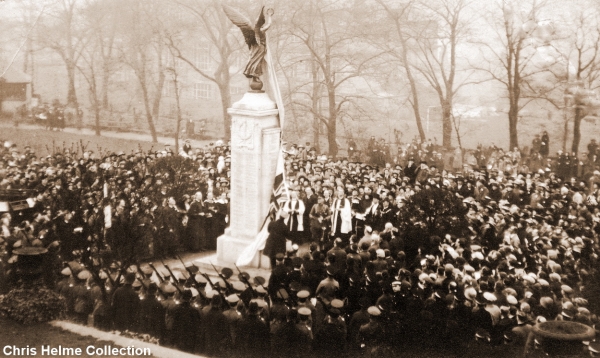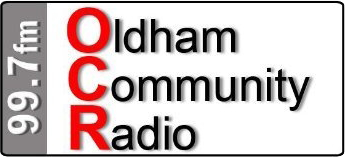The first is at Rydings Park outside the library and art gallery building, and was taken on the day it was unveiled and dedicated.
The date was Saturday, 22 April 1922. Prior to the service was a large procession which left Thornton Square at 3pm. It was led by the mounted police and the officers from the Police Street police station. As with all processions there has to be a band and on this occasion it was the Band of the 4th Duke of Wellington's.
The main body of the procession had representatives from the Brighouse Company, 4th Duke of Wellington's, a Guard of Honour and Buglers (4th Duke of Wellington's), British Legion, Ambulance and Nurses, Boy Scouts and Girl Guides, the local clergy and ministers of the Borough, many visitors who wanted to be present to pay their respects, the War Memorial Committee, Magistrates, all the Borough councillors, aldermen and officials and at the rear were more police representatives. This was one of the largest processions the town had seen for many years.
The unveiling ceremony was carried out by General Sir Ivor Maxse (1862 - 1958), KCB;CVO;DSO, who had fought during the First World War and was best known for his innovative and effective training methods. The dedication was carried out by the Rt. Reverend Rodney Eden The Lord Bishop of Wakefield.
The sixteen page service programme which I have a copy of gives a full account of the service. The last six pages shows a list the fallen and their respective Regiments.
The second photograph dates back to 1956 and shows the two buglers playing the last post on the landing above the war memorial at The Stray, Lightcliffe. The buglers are (left to right) Leslie Hulme and Fred Holt.
The Lightcliffe memorial was unveiled and dedicated on Sunday, 9 September 1923 by J.H.Whiteley. Unlike Brighouse there are no names on this memorial. The memorial was cleaned and repaired in March 2012.
Returning to our featured photograph standing alongside the two buglers are a number of local girls. I wonder if any of those girls are still living in the Lightcliffe and Hipperholme areas?
Our final photograph is at Bailiff Bridge and shows what is probably the largest gathering of local people ever in the village. This is the occasion of the unveiling and dedication of the new war memorial on Saturday, 2 April 1921. The unveiling ceremony was carried out by Field-Marshall Sir William Robertson (1860-1933), Bt; GCB; GCMG; KCVO; DSO. He served as Chief of the Imperial General Staff, the professional head of the British Army from 1916 to 1918 during the First World War.
The dedication was carried out once again by the Rt. Reverend Rodney Eden The Lord Bishop OF Wakefield. He retired in 1928 and from the end of the First World War must have attended many similar dedication services. The war memorial was erected by Sir William and Lady Aykroyd of T.F.Firth's.
The memorial does have list of the fallen. After many years of neglect both the memorial and park have been carefully refurbished to its former glory.
The photograph was taken from a bedroom window in Co-operative Buildings and shows the Field-Marshall just having inspected the soldiers. The large crowds wait for the service to begin.
Other war memorials in our area include: Rastrick which was unveiled 2 October 1920 by Lt.Col. Sir George Armytage. The Clifton war memorial was unveiled by Colonel Sir George Ayscough Armytage on the 19 November 1921. For further information about this memorial I would recommend reading Margaret Sharp's book 'Clifton War Memorial'. Norwood Green war memorial was unveiled by the local clergy on the 11 November 1923. It was designed by Harry Percy Jackson the Coley woodcarver and finally the Southowram war memorial was unveiled by Mayor G.T.Ramsden on the 8 October 1922.
Chris Helme





















